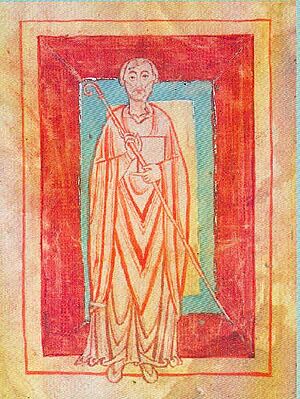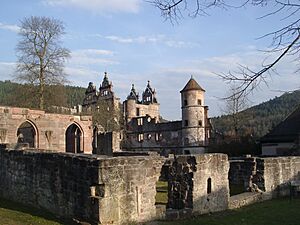William of Hirsau facts for kids
Quick facts for kids BlessedWilliam of Hirsau OSB |
|
|---|---|

William of Hirsau, from the cartulary of Reichenbach Priory
|
|
| Abbot, Reformer | |
| Born | 1030 Bavaria |
| Hometown | Saint Emmeram's Abbey |
| Residence | Hirsau Abbey |
| Died | 5 July 1091 Hirsau Abbey |
| Honored in | Catholic Church |
| Major shrine | Hirsau Abbey |
| Feast | 4 or 5 July |
| Attributes | crosier and book |
William of Hirsau (German: Wilhelm von Hirschau; around 1030 – 5 July 1091) was a Benedictine abbot and a church reformer. He was the abbot of Hirsau Abbey in Germany. William created the Constitutiones Hirsaugienses, which were rules for monks. These rules were based on the practices of Cluny Abbey in France.
William is known as the founder of the Hirsau Reforms. These reforms greatly influenced many Benedictine monasteries across Germany. He also supported the papacy (the Pope) during the Investiture Controversy. This was a big conflict between the Church and kings. In the Roman Catholic Church, William is considered a Blessed person.
Contents
Early Life and Education
William was born in Bavaria, a region in Germany. He was likely born around the year 1030. We do not know much about his family or early childhood.
As a young boy, William was given to the Benedictine monks. He received his education at St. Emmeram's Abbey. This abbey was a special church connected to the Bishop of Regensburg. There, a famous teacher named Otloh of St. Emmeram taught William.
It is believed that William became good friends with Ulrich of Zell at the abbey. Ulrich later became a well-known reformer and a saint. Their friendship lasted throughout their lives. William was known for being very disciplined himself, but also kind to others.
Skills and Discoveries
William became a priest and taught important subjects. He was skilled in mathematics and astronomy. He was also a talented musician. William even improved the design of the flute.
Around the mid-1000s, William wrote important books. These books were about astronomy and music. These subjects were part of the quadrivium, which was a group of four advanced studies. People at the time thought William was one of the best in these fields.
He also built different tools for studying the stars. He made a sun-dial that showed how the sun and other heavenly bodies moved. It could even show the solstices and equinoxes. His famous stone astrolabe can still be seen today in Regensburg. It is over 2.5 meters tall. One side shows an astrolabe sphere. The other side has a drawing of a man looking at the sky. This man is thought to be the ancient Greek astronomer Aratos of Soloi.
Leading Hirsau Abbey
The Counts of Calw had removed the previous abbot of Hirsau Abbey. William was chosen to take his place. He was sent to Hirsau in May 1069. He immediately started managing the monastery. However, he refused to officially become abbot until the old abbot died in 1071. He was formally made abbot by the Bishop of Speyer in 1071.
In his first years, William wanted to make the abbey free from the control of powerful families. He based his ideas on reforms from Gorze Abbey and Cluny. This goal put him against the Counts of Calw, who had a lot of power over Hirsau.
Even though the Emperor Henry IV tried to keep Hirsau under the counts' control, William succeeded. A special order from Pope Gregory VII placed Hirsau under the Pope's protection.
William eventually won against Count Adalbert II of Calw. The count gave up his control over the abbey. Emperor Henry IV then put the monastery under his own protection. The abbey gained "complete freedom" in 1075. This meant they could choose their own abbot and other leaders.
Under William's leadership, Hirsau Abbey became very famous. Even though he brought in very strict rules from Cluny, the number of monks grew a lot. It went from 15 to 150 monks. The old monastery was too small and often flooded. So, William built a new, much larger monastery complex. It was built across the Nagold River after 1083. This new complex included a huge Romanesque church dedicated to Saint Peter. It was the largest monastery complex in Germany at that time.
William turned the old monastery site into a smaller priory. In 1075, William traveled to Rome. He wanted the Pope to confirm Hirsau's freedom. There, he met Pope Gregory VII. William strongly agreed with the Pope's reform ideas. He later supported the Pope in the big conflict with Emperor Henry IV. This conflict was called the Investiture Controversy.
The Hirsau Reforms
William became a main leader of the Church reforms in Germany. From 1079, he brought many ideas from Cluny to Hirsau. He wrote these ideas down in the "Constitutiones Hirsaugienses" (Customs of Hirsau). These rules became very popular and were known as the "Hirsau Reforms."
These reforms focused on strict discipline and obedience for monks. They included tough punishments for breaking rules. Monks were also watched closely all the time.
William also created a new role called the conversi (lay brothers). These were laymen who wanted to help the monasteries. Before this, helpers lived outside the monastery and did not take vows. William's idea allowed many more people to join and support the monasteries.
The Hirsau Reforms became very important in Germany. They influenced many monasteries in the 11th and 12th centuries. About 200 monasteries, both new and old, adopted these reforms. Some new abbeys founded by monks from Hirsau include Zwiefalten, Blaubeuren, St. Peter im Schwarzwald, and St. Georgen im Schwarzwald. Older monasteries that accepted the reforms include Petershausen and Schaffhausen.
William also made a standard version of the Vulgate (the Latin Bible). This was used in all the monasteries that followed his reforms.
William's Influence
William's reforms were popular in parts of Germany like Swabia and Franconia. The spread of the Hirsau Reforms was linked to William's strong support for Pope Gregory VII. He was a key figure for the Pope's side in Germany. He supported the anti-kings, who were rivals to Emperor Henry IV. William's efforts helped keep the Pope's supporters strong in southwest Germany.
William died on July 5, 1091. He was buried in the abbey church at Hirsau.
Legacy and Writings
Besides writing the Constitutiones Hirsaugienses, William also wrote other books. These included "De astronomia" (About Astronomy) and "De musica" (About Music). For a long time, people mistakenly thought he wrote another famous book called "De Philosophia Mundi."
His life story is told in a book called Vita Willihelmi abbatis Hirsaugiensis.
The Benedictine monks remember William of Hirsau on July 4 or 5 each year.
See also
- Hirsau Abbey


